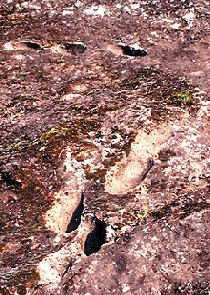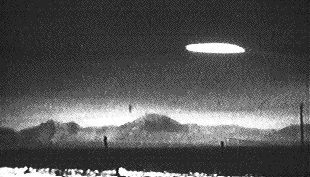Oldest human footprints discovered in Italy
Thursday, 13 March 2003
Markings in hardened volcanic ash, dubbed "devils'
trails" by local Italian villagers, have been confirmed as the
oldest-known footprints ever made by humans.
The fossilised hand and footprints belong to three early humans who were
probably climbing down the side of the Roccamonfina volcano in southern
Italy about 385,000 to 325,000 years ago, report a team of Italian
palaeontologists in today's issue of the journal, Nature.
"We believe that these tracks are the oldest human footprints found
so far," said Professor Paolo Mietto of the University
of Padua in Italy, who lead the research. "They are made by
hominids who had a fully bipedal, free-standing gait, using their hands
only to steady themselves on the difficult descent."
"In some of the prints, the impressions made by the heel and ball
of the foot are clear, and there are even small depressions that can be
interpreted as toe impression," he said.
|

They were made by primitive humans that walked upright with a
free-standing gait and used their hands to steady themselves. Three tracks
with prints show curve or zizgzag patterns. The prints, embedded in
fossilised volcanic ash, are about 20 cm (eight inches) long and 10 cm
wide and belonged to primitive humans who were about 1.5 metres tall.
He added that older footprints of hominids, or human-like ancestors, that
were made by more distant ancestors, date back 3.5 million years and were
found in petrified volcanic ash at Laetoli in northern Tanzania.
Reuters,
Agençe France-Presse |
|
Date: 2003-04-01
Wicca's Wicked Appeal Among the Young
Journalist Carlo Climati Calls for "Culture of Commitment"
as Response
ROME, APRIL 1, 2003 (Zenit.org).-
Among the esoteric phenomena listed in the Vatican's recent document
on New Age is a form of witchcraft gaining popularity among the young.
To better understand the phenomenon, ZENIT interviewed journalist Carlo
Climati, whose book "Young People and Esotericism: Magic, Satanism
and Occultism" has just been published in Spain. The book is already
a best seller in Italy and Latin America.
Q: What is Wicca?
Climati: It is a neo-pagan cult that originated in the Anglo-Saxon world
and appears as a sort of "good witchcraft." It is neither a sect
nor an organization with specific leaders and structures. It is simply a
current of esoteric thought that any person can follow without any
particular commitment.
Q: What does this current of thought suggest?
Climati: It is a mixture of paganism, magic and superstition. In addition,
it gives exaggerated veneration to nature, to the point of divinizing and
adoring it. Wicca followers believe in reincarnation, which they regard as
an "evolution of the soul." They practice a series of magic
rites: from enchantments of love to ceremonies to become rich or
"attract money."
At times they turn to spirits, non-physical entities or pagan gods, such
as praying to the horned god.
Q: Why does Wicca appear as "good witchcraft"?
Climati: Because Wicca followers say that they don't want to harm anyone
and that they reject Satanism. However, from my point of view, Wicca
cannot be regarded as a positive cult.
In some cases, it suggests rituals that seek to exercise power over
people. However, human beings are not puppets who can be controlled as one
wishes.
Another negative aspect is that of superstition. Wicca followers are
convinced that stones, herbs and the wind contain particular energies
capable of producing effects on daily life. Thus they end up by becoming
slaves to objects, amulets and talismans.
Q: Is it true that Wicca is popular among young people?
Climati: Unfortunately, yes. Some movies and telefilms have made Wicca
popular. Some magazines for adolescents also speak of it frequently,
proposing it as a kind of "alternative religion."
Girls in particular are fascinated by the idea of being "good
witches," and they use Wicca rituals to solve problems of daily life.
They shut themselves in their room and prepare real ceremonies with
candles, incense and little altars dedicated to some strange divinity.
|

Q: Do you think this has risks?
Climati: The risk of hiding behind Wicca is clear. It is the invitation to
believe that there is a "good magic," a kind of "ally"
to resolve the problems of everyday life -- a life that, in the case of
many young people, is dominated by loneliness, the absence of conversation
in the family, difficulties with studies and with the first steps in the
working world.
When one is alone it is easier to be a victim of magic and superstition.
One latches on to everything, including an amulet. From my point of view,
Wicca finds fertile ground in the life of many young people who are often
faced with difficult family situations, lack of communication, silence,
disappointments and uncertainty about the future.
Q: What effect can Wicca have on young people's behavior?
Climati: In the long term, there is the risk of spreading lack of
commitment among young people. They trust something that is outside their
own life to resolve a problem. Young people refuse to be committed to
achieve an objective, leaving everything in the hands of the so-called
energies of some ritual or amulet.
It is the law of "I want everything now." Do I like a girl?
Instead of winning her over by being pleasant and tender, the Wicca
follower will turn to a magic rite. Do I have doubts about the future?
Instead of using his head to find an intelligent solution to the problem,
he entrusts himself to Wicca. The same thing happens with school and
university examinations.
Q: Is it possible to help young people so that they will not be exposed to
such risks?
Climati: It is necessary to foster a new "culture of commitment"
that values the little efforts of daily life to achieve a particular
objective. If one wants to succeed in attracting a girl, one doesn't have
to buy an amulet but give her a bunch of flowers.
In addition, it is opportune to promote a "culture of limits,"
that is, to make young people understand that they cannot have it all. It
is necessary to be able to set one's own limits. If I don't succeed in
having the love of a boy or girl, it is of no use to turn to Wicca to
change the situation. I must accept this little failure and submerge
myself again in daily life, seeking with new enthusiasm to find my real
love.
A healthy rediscovery of the culture of limits and personal commitment
could undoubtedly help young people to be stronger, to face life better,
to overcome uncertainties and fears, and not have to turn to Wicca
superstitions.
|
UFO sightings increase sharply in
2002 and once again B.C. leads Canada
SCOTT
EDMONDS Canadian Press
Wednesday, February 12, 2003
WINNIPEG (CP) - From white cylinders in British Columbia to an
object with windows and flashing lights near Inkerman, N.B., last year
was a banner one for sightings of unidentified flying objects over
Canada.
"In 2002 we had the largest number
of separate events for a single year in the history of collecting UFO
data for Canada," Chris Rutkowski of Ufology Research of Manitoba
said Wednesday. "We have some extraordinary cases in Canada last
year reported literally from one end of the country to the other."
Since 1989 his group has been compiling reports from across Canada.
There were 483 UFO sightings reported in
2002 - almost 30 per cent more than in 2001 and a 250 per cent increase
since 1998.
That's a record if 1993 is excluded when
one celestial fireball contributed to a high of 489 reports that year,
explained Rutkowski, who added that 154 of them were easily explained
because of the fireball.
"Overall it's fascinating to see
that the number of cases in Canada rose so dramatically last year,"
he said.
There is no easy explanation for the
increase, he added.
Rutkowski said one of the strangest
unexplained sightings occurred in January 2002 near the tiny community
of Inkerman, N.B.
"A large object with flashing lights
and brightly lit windows flew slowly and fairly silently over a
highway," he said.
"A couple stopped their car and
watched it as it moved down behind some trees."
It was one of the sightings he looked
into personally.
Overall, British Columbia was once again
the place to be in 2002 to see a UFO. The province produced 176
sightings, more than Ontario and Quebec combined and up from 123 in
2001.
B.C.'s numbers represent a third of all
UFO sightings in Canada. Rutkowski said part of the reason is likely due
to two UFO organizations in the province which have done a good job
encouraging reports, although he suggested that doesn't tell the whole
story.
"I don't think that the increase can
be ascribed completely to the fact people are looking up a little more
or know where to report."
Many of the reports from British Columbia
come from the north of the province, not the densely populated south.
"In the Yukon there (also) still
seems to be an extraordinarily high number of cases," he noted.
The Yukon produced 20 reports last year
and has consistently produced about that many or more since 1998.
Ontario produced 128 reports last year,
Alberta 51, Manitoba 36, Quebec 34, Nova Scotia 23, Saskatchewan 6, New
Brunswick 4, Newfoundland 3 and Nunavut 2. Prince Edward Island and the
Northwest Territories were UFO-free zones in 2002.
In general, more UFOs were reported in
late summer than any other time of the year, although February also
produced a peak.
About 18 per cent of all UFO reports
remained unexplained but only about seven per cent were what researchers
consider high-quality cases. Most sightings involved at least two
witnesses and lasted approximately 15 minutes.
Rutkowski and the other researchers who
helped compile the report don't draw any conclusions from the sightings
and don't suggest alien spacecraft are visiting planet Earth.
|

"As with previous
studies, the 2002 Canadian UFO survey does not offer any positive proof
that UFOs are either alien spacecraft or a specific natural
phenomenon," notes the report.
"However, it does show that some
phenomenon, which is often called a UFO, is continually being observed
by witnesses."
(CP) - Here's a list of some
unidentified flying objects sighted by Canadians in 2002:
Jan. 12, 2002, 9:40 p.m., Inkerman, N.B. -
A couple in a car watch a large object with flashing lights and brightly
lit windows fly slowly and silently over a highway. Dozens report
sightings about the same time.
-
March 28, 2002, 10:30 p.m., Hamilton, B.C.
- A pale-coloured light rises from a mountain, then disappears. It repeats
this performance several times.
-
April 7, 2002, 1:57 a.m., Hudson's Bay,
Nunavut - The aircrew of a cargo plane watch a small light grow in size to
become a jagged ball, then fizzle out.
-
May 7, 2002, 11:23 p.m., Winnipeg - A fuzzy
patch of light is seen and photographed near the Big Dipper by an
experienced astronomer and physicist. It was not a comet, cloud, or any
other known phenomenon.
-
May 26, 2002, 11:44 p.m., Winnipeg - Three
people watch a dark object with three red circles on its underside
silently glide across the sky.
-
July 28, 2002, 10:00 p.m., Smithers, B.C. -
A barrel-shaped silver object flies across the sky towards the southwest.
-
Aug. 13, 2002, 1:00 a.m., Waterville, N.S.
-Twelve witnesses watch two luminous silver objects fly silently over an
RV park, then one of the objects angles sharply away and is lost to sight.
-
Aug. 13, 2002, 2:15 a.m., Cow Bay, N.S. - A
huge, slow-moving black triangular object appears to block out the sky.
Inquiries with radar operators confirm a large unknown object had flown
over the area at that time.
-
Aug. 23, 2002, 7:00 p.m., Houston, B.C. - A
shiny white cylindrical object flies overhead and is videotaped.
-
Sept. 1, 2002, 8:47 p.m., Molega Lake, N.S.
- Two witnesses watch an object with rectangular slit-like lights and a
large red flashing light fly slowly eastward.
-
Sept. 22, 2002, 3:13 p.m.,Vancouver - A
small orange object moves slowly in the sky, changes direction and shape,
and is observed for hours by more than a dozen people.
-
Oct. 22, 2002, 10:25 p.m., Granisle, B.C. -
An orange disc-shaped object hovers over a mine, then slowly rises and
flies north until it's out of sight.
© Copyright 2003 The Canadian Press |



